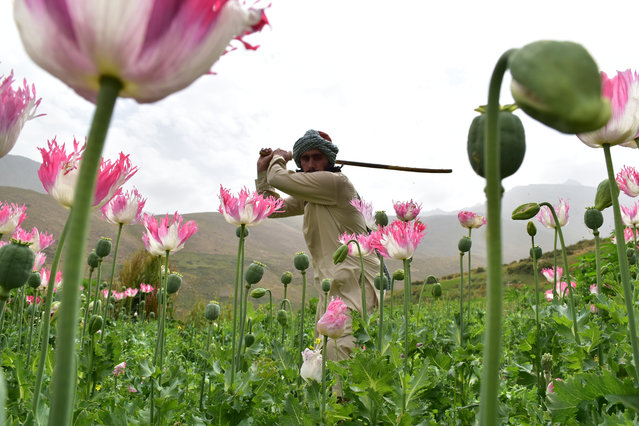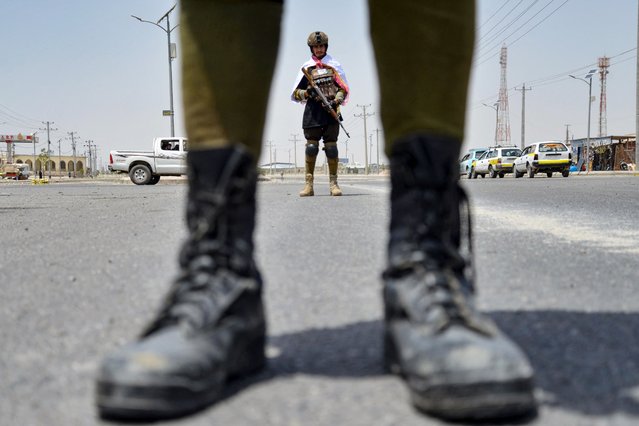
A boy who was injured in roof collapse due to torrential rains, is shifted to a hospital in Jalalabad, Afghanistan, 15 July 2024. At least 35 people were killed and 230 injured in eastern Afghanistan after heavy rain caused by thunderstorms led to collapsed trees, walls, and roofs of houses, Quraishi Badloon, head of the department of information and culture said. This tragedy follows previous flash floods in May that had devastating effects on the country's population. (Photo by Shafiullah Kakar/EPA/EFE)

People watch as Afghans firefighters work to extinguish a fire that engulfed a vehicle spare parts market in Spin Boldak District in Kandahar, Afghanistan, 19 July 2024. According to the district governor Mullah Abdullah Bashir, the fire that broke out in Boldak District in Kandahar main vehicle spare parts market destroyed more than 2,500 shops and millions of dollars were damaged in this fire. (Photo by Qudratullah Razwan/EPA)

Afghan boys search for recyclable materials at a garbage dump on the outskirts of Mazar-i- Sharif on July 25, 2024. (Photo by Atif Aryan/AFP Photo)

An Afghan boy sits on his cart of ice-creams as he waits for customers along street in Herat on July 29, 2024. (Photo by Mohsen Karimi/AFP Photo)

Anti-Narcotics Police of Baghlan starts the operation to destroy drug farms four months ago and this operation is still ongoing in Baghlan, Afghanistan on July 29, 2024. Mullah Mohammad Nabi Kamran, director of anti-narcotics in Baghlan Police Command, says that during the last four months, nearly 6000 acres of poppy fields have been destroyed and this operation will continue until Baghlan Province is completely cleared of drugs. (Photo by Stringer/Anadolu via Getty Images)

Afghan boys jump into a canal on the outskirts of Kandahar province on July 30, 2024. (Photo by Sanaullah Seiam/AFP Photo)

Taliban security personnel stand guard at a checkpoint in Kandahar on August 13, 2024, on the eve of the third anniversary of Taliban's takeover of Afghanistan. (Photo by Sanaullah Seiam/AFP Photo)

Members of the Taliban carrying flags participate in a rally to mark the third anniversary of the fall of Kabul, in Kabul, Afghanistan on August 14, 2024. (Photo by Sayed Hassib/Reuters)

Taliban fighters celebrate the third anniversary of the withdrawal of US-led troops from Afghanistan, in Lashkar Gah, Helmand province, southwestern Afghanistan, Wednesday, August 14, 2024. (Photo by Abdul Khaliq/AP Photo)

An Afghan farmer places fresh grapes inside a drying tent in Panjwai district of Kandahar province on August 19, 2024. (Photo by Sanaullah Seiam/AFP Photo)

An Afghan worker offers his evening prayer at a brick kiln on the outskirts of Kandahar on August 21, 2024. (Photo by Sanaullah Seiam/AFP Photo)

An Afghan man carries inflatable tubes along a riverside in Lashkar Gah, capital of Helmand province on August 26, 2024. (Photo by Wakil Kohsar/AFP Photo)

An Afghan man looks on during a mixed martial arts class at a club in Kabul, Afghanistan, 27 August 2024. The Taliban administration has officially banned Mixed Martial Arts (MMA)/Free Fight, deeming it incompatible with Islamic teachings. It was announced by the Ministry for Promotion of Virtue and Prevention of Vice to the National Olympic and Physical Training Committee, citing concerns over violence and safety risks associated with the sport. The ban went into effect on 27 August, with some clubs being able to practice into the evening due to the time taken to communicate the edict across the country. Ahmadullah Vathiq, head of the Taliban's physical training, stated, “After research, it became clear that this sport has problems from the point of view of Sharia... it has no right to continue its activities in Afghanistan”. This ban adds to the growing list of restrictions imposed by the Taliban, including previous prohibitions on women participating in sports. (Photo by Samiullah Popal/EPA/EFE)

An Afghan woman shows a painting at the 'Afghanistan's Economic Development and Success' in Kabul, Afghanistan, 27 August 2024. A four-day exhibition titled “Afghanistan's Economic Development and Success” has opened in Kabul, showcasing products from industrialists in 310 booths, with 150 dedicated to handicrafts. The Taliban Ministry of Industry and Trade said it emphasizes the importance of such exhibitions for promoting domestic products to enhance economic growth. The Chamber of Commerce and Investment reports a significant increase in exports and a decrease in imports, highlighting the role of the private sector in this progress. Additionally, the Chamber of Agriculture and Livestock stresses the need to support agriculture for overall economic development. (Photo by Samiullah Popal/EPA/EFE)

Afghan girls read the holy Koran at Madrassa Abdullah Bin Omar darul uloom (Islamic school) in Kandahar on August 28, 2024. (Photo by Wakil Kohsar/AFP Photo)

In this photo taken on August 29, 2024, an Afghan burqa-clad woman walks past an energy drink advertisement at Kandahar airport in Kandahar. The Taliban government has purged many signs of Western influence but a stimulant drink craze that arrived with US soldiers remains, and has even sprouted a thriving domestic industry. Alcohol is outlawed in Afghanistan but caffeine-rich energy drinks are guzzled by secret police, fed by mothers to suckling children and advertised on billboards more than even Taliban state propaganda. (Photo by Wakil Kohsar/AFP Photo)

Afghan children attend an open-air school in Firozkoh, Ghor province on August 31, 2024. (Photo by Mohsen Karimi/AFP Photo)

Armed Taliban security personnel sit atop a humvee armored vehicle, as they ride along a street in Khash district, Badakhshan province on September 1, 2024. (Photo by Omer Abrar/AFP Photo)

A boy plays on a trampoline on the outskirts of Mazar-i-Sharif on September 11, 2024. (Photo by Atif Aryan/AFP Photo)

A laborer who works on daily wages waits for customers on a roadside in Kabul, Afghanistan, 10 September 2024. The International Organization for Migration (IOM) has identified Afghanistan as one of the ten most vulnerable countries to climate change, highlighting that since 2022, climate change has become the primary cause of internal displacement, surpassing war. The report notes that droughts and severe floods have impacted over half of Afghanistan's population, leading to water scarcity, land degradation, food insecurity, and significant economic challenges. The United Nations refugee agency reports that the number of internally displaced persons in Afghanistan has exceeded three million, illustrating the dire consequences of climate-related disasters in the region. (Photo by Samiullah Popal/EPA/EFE)
30 Sep 2024 04:44:00,
post received
0 comments
